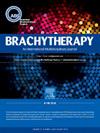GPP02 演讲时间:上午 9:09
IF 1.7
4区 医学
Q4 ONCOLOGY
引用次数: 0
摘要
目的 IGABT 在低收入国家和地区的应用有限。这可能是因为缺乏轮廓塑造、容积计划评估和磁共振成像方面的培训。在大多数中心,CT 扫描至少常规进行一次,并在原位使用涂抹器,但目标和 OAR 的剂量仍按点进行报告和优化。在放射治疗过程中,很少在任何时间点进行核磁共振成像,近距离放射治疗计划是每周进行 3-4 次分次治疗,从而延长了总治疗时间,使其超过 55 天。研讨会的重点是使用声波图放置涂抹器、基于 CT 扫描的轮廓和规划以及容积剂量限制、在可行的情况下使用带 T2 序列的 3D MRI,以及在可用的情况下使用混合涂抹器。第一天是关于指南、轮廓和数据的讨论,然后由所有医生动手在 CT 扫描上对 3 个病例进行轮廓分析。第二天,通过现场病例演示了整个工作流程,包括超声波的使用、混合涂抹器的放置、CT 扫描和核磁共振成像的轮廓分析以及临床目标的规划。随后,大多数医生被要求在专家或本网络中心的 IGBT 同行医生在场的情况下进行 IGBT 手术。研讨会结束后,所有参与者都被要求分享匿名数据,以便对实践模式进行分析。结果来自 6 个地点的 15 名医生中有 11 名同意分享他们的剂量测定和早期结果数据。所有 11 名医生都从 A 点过渡到了基于容积的规划,并连续对 257 名患者进行了 IGBT 治疗(85% 基于 CT,15% 基于 MRI)。76%的患者在近距离放射治疗前进行了骨盆核磁共振成像检查。最常见的 EBRT 剂量计划为 45 分 25 次(60%),HDR 计划为 21-28 Gy 分 3-4 次(95%)。在网络中接受 EBRT 治疗的患者中,97.2% 接受的 EBRT 剂量为 45 Gy(25 次/分),HDR 剂量为 28 Gy(4 次/分)。大多数人(86%)只接受了腔内治疗,14%的人使用了混合治疗仪。直肠、膀胱、乙状结肠和小肠的HRCTV和D2cc的中位D90分别为80.8Gy(79.28-85.05Gy)、62.18Gy(57.5-66.8Gy)、63.87Gy(582-72Gy)、61.2Gy(55.5-68.6Gy)和55.1Gy(45-63.6Gy)。所有患者中分别有 64.9% 和 78.9% 的人总治疗时间少于 50 天和少于 55 天,而在同一部位接受 EBRT 加支架治疗的患者中分别有 72.2% 和 88.9% 的人总治疗时间少于 50 天和少于 55 天。148名患者接受了3-6个月的首次随访,其中138名患者(93.9%)获得了临床和/或代谢完全反应。结论这种通过教育和培训确定基线实践模式的工作坊模式侧重于 RT 治疗的特定质量方面,随着 IGBT 的采用、MRI 的使用和总体治疗时间的缩短,这种模式发生了显著变化。从基于点的 IGBT 过渡到基于 CT/MRI 的 IGBT,临床目标的依从性很高,早期反应也很好。本文章由计算机程序翻译,如有差异,请以英文原文为准。
GPP02 Presentation Time: 9:09 AM
Purpose
The adoption of IGABT is limited in LMIC. This could be from lack of training in contouring, evaluation of volumetric plan and access to MRI. In most of the centres CT scan was routinely done for at least one fraction with applicator in situ but dose to target and OAR was still reported and optimized to points. MRI was seldom done at any point during course of radiation and brachytherapy schedule was 3-4 fractions performed weekly prolonging total treatment duration to be more than 55 days.
Methods
Live and virtual workshop was performed over 1.5 days for hands on training with both physicians and physicists from all sites in December 2022. Workshop focused on use of sonogram for placement of applicator, CT scan-based contouring and planning with volumetric dose constraints, 3D MRI with T2 sequence whenever feasible, and use of hybrid applicator when available. First day was discussion on guidelines, contouring and data followed by hands on contouring of 3 cases on CT scan by all physicians. On second day entire workflow was demonstrated with live case with use of ultrasound, placement of hybrid applicator, contouring on CT scan and MRI and planning with clinical goals. Later most of the physicians were asked to perform IGBT procedure in the presence of an expert or a fellow physician practicing IGBT at their centre in this network. All participants were asked to share anonymized data for analyses of practice pattern after the workshop. The data was collected after 13 months from the initial workshop.
Results
Eleven out of 15 physicians from 6 sites agreed to share their dosimetry and early outcome data. All 11 physicians transitioned from point A to volume-based planning and treated 257 consecutive patients with IGBT (CT based 85% and MRI based 15%). 76% had MRI pelvis done before brachytherapy as part of workup. The commonest EBRT dose schedule was 45 in 25 fraction (60%) and HDR schedule was 21-28 Gy in 3-4 fraction (95%). For those who had EBRT in the network 97.2% received EBRT dose of 45 Gy in 25 fractions and HDR Schedule of 28 Gy in 4 fractions. Majority had intracavitary alone (86%) while 14% used hybrid applicator. Median D90 for HRCTV and D2cc for rectum, bladder, sigmoid and small bowel were 80.8Gy (79.28-85.05 Gy), 62.18Gy (57.5-66.8Gy), 63.87Gy (582-72Gy), 61.2 Gy (55.5-68.6Gy) and 55.1 Gy (45-63.6Gy) respectively. Overall treatment time was ≤ 50 days and ≤55 days for 64.9 % and 78.9% respectively for all patients and 72.2% and 88.9% for patients who received EBRT plus brachy at same location. The first follow up between 3-6 months was available for 148 patients and 138 (93.9%) had clinical and/or metabolic complete response.
Conclusion
This workshop model of Identifying baseline practice pattern with education and training focused on specific quality aspect of RT delivery showed significant changes with adoption of IGBT, use of MRI and reduction of overall treatment time. The transition from point based to CT/MRI based IGBT was with high adherence to clinical goals and excellent early response.
求助全文
通过发布文献求助,成功后即可免费获取论文全文。
去求助
来源期刊

Brachytherapy
医学-核医学
CiteScore
3.40
自引率
21.10%
发文量
119
审稿时长
9.1 weeks
期刊介绍:
Brachytherapy is an international and multidisciplinary journal that publishes original peer-reviewed articles and selected reviews on the techniques and clinical applications of interstitial and intracavitary radiation in the management of cancers. Laboratory and experimental research relevant to clinical practice is also included. Related disciplines include medical physics, medical oncology, and radiation oncology and radiology. Brachytherapy publishes technical advances, original articles, reviews, and point/counterpoint on controversial issues. Original articles that address any aspect of brachytherapy are invited. Letters to the Editor-in-Chief are encouraged.
 求助内容:
求助内容: 应助结果提醒方式:
应助结果提醒方式:


